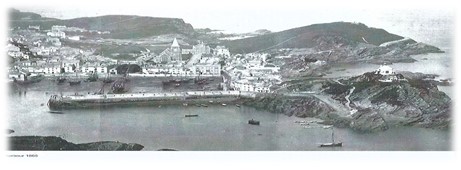
Ifracombe is surrounded by an area of outstanding natural beauty, located within an undulating landscape of hills and valleys on one side and the turbulent Bristol Channel on the other. The town was originally made up of two communities, one based on making a living out of farming as far back as the 12th century, the other a fishing community based around the natural harbour.
The Bristol Channel has been one of the world’s busiest highways for trade and for exploring the world for many hundreds of years, with Ilfracombe harbour becoming registered as a significant port of refuge; this is typified by the many tributes and stories of those who didn’t make it to the safety of the harbour. There are some 2000 recorded shipwrecks in the area; the fate of one shipwreck in particular, the transport ship London, is a stormy tale full of intrigue and drama (see link ship wrecks).
Ilfracombe is home to one of the earliest examples of a lighthouse in Britain, St. Nicholas Chapel, built in the 13th Century on Lantern Hill, overlooking the harbour.
In 1607 a major tsunami hit the Bristol Channel causing damage over 200 square miles with 2000+ lives lost: a large proportion of the estuary’s population at that time. Water levels were recorded reaching 8ft (2.4m).
Early on Ilfracombe developed trade routes between Kinsale and Tenby and later the rest of the world. Until the mid-19th century Ilfracombe’s economy was based around maritime activities, such as importing limestone and coal from Wales and fishing for herring, plus international trade including to West Africa and the West Indies. During the Regency period the town, population then 1800, was home to many navy personnel including Admirals, Captains and other commissioned sailors.
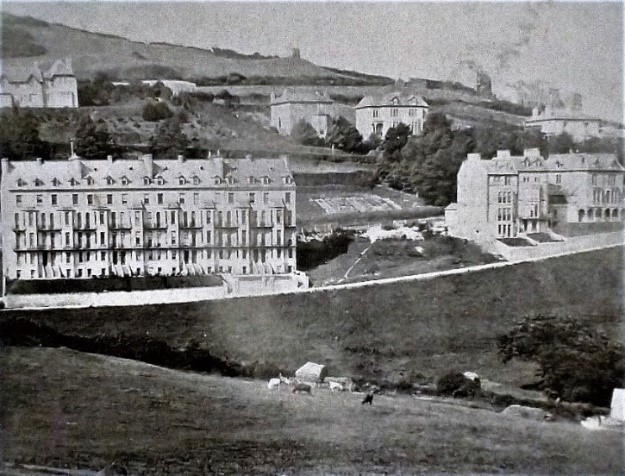
Buildings in the town are a mix of mainly Georgian and Victorian terraces – Coronation Terrace was the first to be built in 1820. Larkstone Terrace is the longest terrace in the town overlooking Hillsborough and the harbour. Pictured to the left is a photo taken in 1872 which shows the east portion known at the time as Laston Terrace and to the west Tawstock place. In the 1880’s the gap was filled with an additional 6 properties and it was at that point the terrace was called Larkstone. The Terrace looks out over Larkstone Cove, the name of which originates from the practice of ballast being dumped in the cove (‘The Last Stone’). This practice means that stones and rocks from all over the world have ended up in this cove, making it a geologists’ dream.
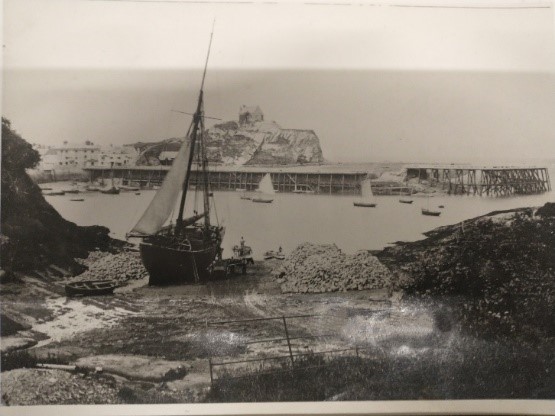
The picture on the left from 1912 shows a sailing ketch in Larkstone cove, possibly the Salina Mary, used for bringing limestone and coal from Wales for domestic use and for burning in lime kilns This would turn limestone into quick lime, which was essential for farming (a ton an acre was needed to improve farmland for crops and grazing).
Today we see the new embracing the old in the cove with Ilfracombe’s newest addition, the Watersports Centre, including a restored, original lime kiln within its development and giving the café located there its name.
In this photo you can also see the original wooden promenade pier built in 1873 (replaced in 1952) to allow pleasure steamers to moor up at all tides.
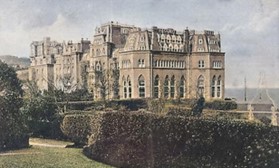
Tourism has been a major part of the economy in Ilfracombe, starting with the arrival of the railway in 1870 and the many paddle steamers that would come laden with tourists. During its boom in the 1950’s 10,000 visitors could be seen arriving in the town during peak times. In its day Ilfracombe was home to a number of the country’s most prestigious and luxurious Hotels such as The Granville and The Ilfracombe Hotel pictured left.
With the explosion of foreign package holidays in the 60’s and the closure of the railway in 1970, this boom time ended. Although people are still drawn to Ilfracombe in their thousands, it is now by car and coach that visitors arrive. The coastal path also brings in its fair share of tourists on foot, who often stop in one of its many hotels and B&Bs.
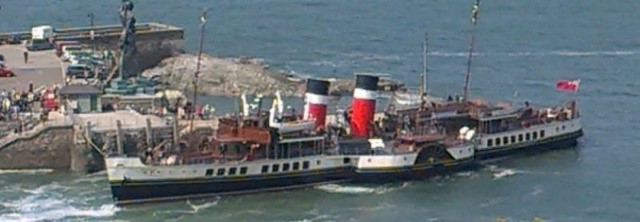
( see link The PS Waverley,) the last sea going paddle steamer in the world, still operates today in the Bristol channel and can be seen arriving at Ilfracombe over the summer months. Arriving first in Ilfracombe in 1887 the original vessel was lost during the Dunkirk evacuation and rebuilt in 1946. The Waverley has had a renaissance post covid and although expensive to maintain (7 million pounds spent in 2000 and 2003), demand is high for passage on this beautiful boat. Carrying a maximum of 700 passengers it now runs on red diesel, not coal, and the future seems bright for this precious link to our past.
Conservation has become an important consideration for the town in recent times with two nature reserves, Hillsborough to the east and the Cairn to the west. The seas off Ilfracombe from Bideford to Forland point where designated into a Marine Conservation Zone (MCZ) in 2016 and in the early 80’s nearby Lundy Island and its surrounding waters were designated as a Marine Nature Reserve, the first of its kind in Britain.
There are a number of famous people associated with Ilfracombe including Peter Sellers whose parents ran the Gaiety Theatre and further back Beatrix Potter took inspiration for one of her books whilst on holiday here. Anna Parnell, the famous Irish Nationalist who lived in the town, is buried at the Holy Trinity Church, having drowned in The Tunnels sea pool in 1911. In more recent times Ilfracombe has been home to the artist Damien Hirst.
References and other links
https://beafordarchive.org/?s=Ilfracombe
https://beafordoldarchive.org.uk/frontend.php
https://www.ilfracombemuseum.co.uk/
https://en.wikipedia.org/wiki/Ilfracombe
https://www.facebook.com/TheIlfracombeHistoryForum/?locale=en_GB
http://www.paddlesteamers.info/BristolChannel.htm
https://paddlesteamers.org/psps-ships/waverley/technical/
http://www.disused-stations.org.uk/i/ilfracombe/
https://johnhmoore.co.uk/hele/
https://en.wikipedia.org/wiki/Anna_Catherine_Parnell
a fun link to track shipping anywhere in the world https://ship-tracking.net/

